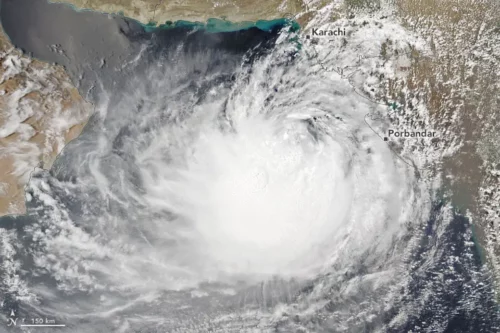Rama Krishna Sangem
Cyclone Biparjoy luckily crossed Gujarat coast June 15, Thursday night without much loss of life, after threatening governments for about 10 days.
Now, India has reached a stage where cyclones are no longer a major calamity – where hundreds of people died like they used to some years back. It’is not that now there are no deaths, but the toll is minimized. As per latest reports, death toll of Biparjoy is in single digits – 4. This may go up, but not in hundreds.
Remember decades ago, when cyclones used to be devastatingly dangerous. Hundreds or even thousands used to die due to high tidal waves or flooding of low lying areas. Year 1977 will forever be etched on our memories as more than 10,000 people died in Divi Seema of Krishna district in Andhra Pradesh, thanks to a killer cyclone in Bay of Bengal. People even now recall it with horror and fear.
Even another super cyclone in Bay of Bengal that stuck Odisha in 1999 killed more than 5,000 people in coastal districts of Puri, Jagatsinghpur and Paradeep. Capita city Bhubaneswar remained without electricity for about a week. I along with another colleague – P Ram Mohan – from Indian Express daily covered the cyclone damage and rescue operations in Orissa. A few more killer cyclones too hit Tamil Nadu, Bengal, Orissa and AP subsequently.
However, cyclones ceased to be that dangerous over the last one decade or so. Even now, their intensity is the same. Wind speed or impact of its landfall is the same. The amount of rainfall to is no less. Still, they are no more feared for bringing huge death toll. Initially, Andhra achieved a greater success over cyclones from 2015 onward and later on, Tamil Nadu and Orissa too did it – escaping higher deaths from cyclones.
Forewarning, evacuation and rescue.
A major change that came in management of cyclone disaster management is deployment of scientific and advanced technological methods. Advent of private meteorological agencies like Skymet etc along with IMD have sharpened forewarning systems. Deployment of Nation Disaster Relief Management forces for evacuation of large number of people helped avoiding huge loss of life.
Interestingly, the state governments, particularly, those along the coastlines have fine tuned their cyclone preparedness over the last decade. First the states on the east coast have improved their capabilities, then those on the west coast too followed. Coordination between revenue and police forces and arrangements for relief camps – from 3-4 days to a week or more – have helped people stay there, instead of their homes in low lying areas.
A senior official who earlier worked in Andhra government’s command control system told me that they had used FM radio stations to warn public on impending cyclone movements from time to time. “This has alerted the public and they stayed at safer places at least a few hours before the landfall of cyclone storm,” the IAS officer explained. Due to repeat exercises, governments are now able to evacuate 50,000 – 1,00,000 people without much effort.
Public too have grown wiser. They no longer resist shifting to evacuation and relief centres. Some years ago, they used to complain about poor or lack of food and drinking water at these shelters. Now they are better organised. Good thing to know is even Pakistan has mastered the art of cyclone evacuation of people – they did it with 60,000 people now for Biparjoy. There will be some loss of property or some isolated deaths, but definitely not in thousands.
This puts India now on par with developed countries like the US and Canada in cyclone relief and rescue operations. We must appreciate our authorities for this improvement.


